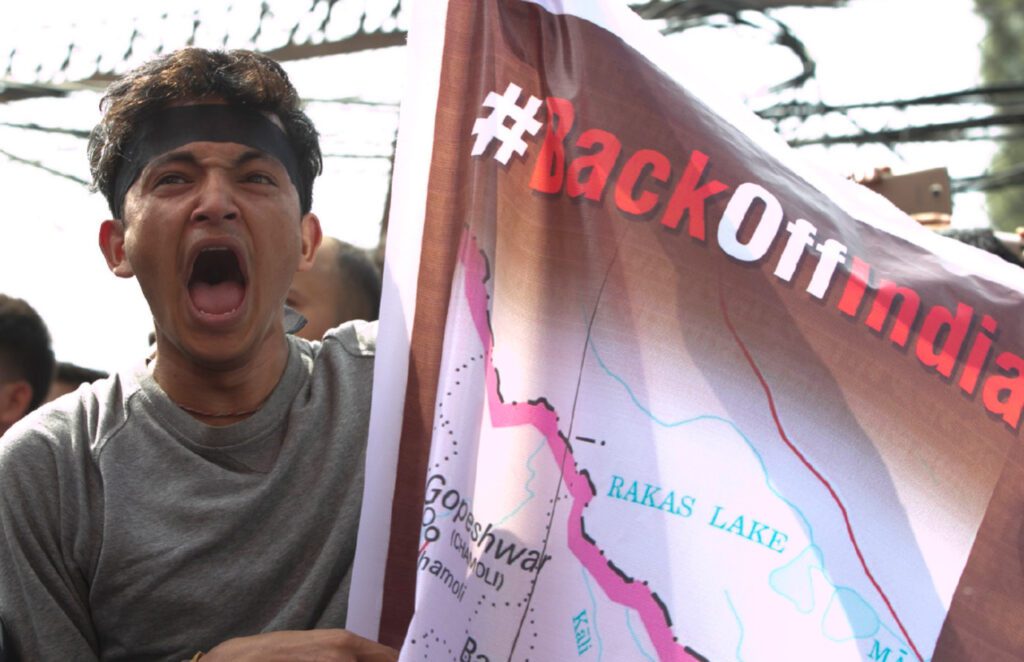IN THE BACKDROP OF RECENT DISPUTE WITH CHINA AND NEPAL
As it attempts to strong-arm smaller states to further it’s hegemonic agenda, India has disillusioned the world to its claim of being an ethical democracy. Pakistan has identified India as the regional hooligan since it’s independence, fighting its ulterior ploys on every front. However, now, the need to curb its efforts is greater than ever, as it it tries to dominate China and Nepal.
Acountry that has derived its national philosophy from schemers like Chanakya who had out rightly preached subtle wars against the fellow states has gradually reached a point where it no longer feels the need for covertness to extend its belligerence. The self-proclaimed big brother of South Asia, India, under its current ultra-Hindu-nationalist leadership is all geared up to ascend the revisionist and irredentist paradigm in a bullish way.
India’s hegemonic aims were never veiled by its national leadership. They not only perceived India as a natural leader of the South Asian region given its size, location, and economic potential, but the founding fathers like Nehru also foresaw it as a major player on the world stage owing to the ‘greatness of their country’. This very desire of recognition and national prestige kindling in their hearts since independence when met with the rising wave of Hindu nationalism in the country emboldened India to exert itself as an indispensable player in the region.
India is currently being ruled by the Bharatiya Janata Party (BJP) under the premiership of Narendra Modi who is a great devotee of Hindu nationalism stalwart, Shri M. S. Golwalkar. Golwalkar viewed International Politics as a place where the law of jungle applied and advocated for a martial (Hindutva) spirit in the nation that can strike terror in the hearts of others. India, under the leadership of Narendra Modi is pursuing the same ethos of Golwalkar by openly pursuing hegemonic as well as expansionist aims. These very actions of India, nevertheless, have come to take a toll at the overall stability of the South-Asian region.

India might have successfully deceived the world with its chauvinistic diplomacy that it was a proponent of Vasudhaiva Kutumbakam (Sanskrit for ‘the world is one family’), but its neighbors have come to fully understand its nefarious designs. India’s ongoing fervent military acquisitions and its ambitious force posture developments have also cautioned its neighbors of its expansionist outlook.
India has never been friendly to its western neighbor Pakistan as it never accepted its creation and the ensuing Kashmir issue further served to deteriorate the relations between the two. Nevertheless, driven by its hegemonic spirit, is has also not spared the other neighbors and continues to evoke terror in its relatively smaller South-Asian neighbors by interfering in their domestic affairs. Almost every neighbor of India has some sort of dispute going on with it, be it a territorial or a political one. India which only used to bully its comparatively smaller neighbors has now ramped up to openly challenge the neighboring great power China too. The recent happenings in the South Asian region are portraying a picture that India’s neighbors have effectively deciphered its designs and refused to submit.
Amidst the pandemic when the whole world is battling the common threat of coronavirus, thanks to the expansionist fervor of the state of India, South Asia has yet again become a flashpoint as tensions have soared in the Himalayas. The roof of the world is witnessing another military brawl between the nuclear-armed neighbors, China and India. Similarly, the border dispute which had been brewing for years between India and the smaller Himalayan state of Nepal has also come to the fore with the angered Nepal remonstrating strongly against India’s recent expansionist surge.
The Dispute with China
China and India formally began their diplomatic ties in 1950 when India ended ties with Taiwan and recognized the People’s Republic of China. Since independence, the relationship between the two Asian neighbors has been complex and inherently competitive. Both the states despite having cooperative diplomatic and economic ties had occasionally engaged in tense border standoffs and also an all-out war, back in 1962.
China and India have around 2100 miles loosely demarcated border which is commonly termed as Line of Actual Control (LAC). Both the states, who see themselves as the heirs of ancient empires, have different positions as to where the actual boundary lies and also at numerous points extend claim to areas administered by the other. For instance India claims Aksai Chin (the Chinese Administered Kashmir) as well as the part of Kashmir ceded by Pakistan to China. Similarly, China lays claim on Arunachal Pradesh (northeastern most state of India) which it regards as part of South Tibet.
Despite the fact that the two states had been holding conflicting geo-political positions, they did manage to avoid a deadly clash for forty-five years. Even in the fairly recent Doklam crisis of 2017, where the troops engaged in a 73-day standoff, not a single casualty occurred. However, it was until the June of 2020 when the two engaged in an eye ball to eye ball situation at the LAC in the Ladakh region of the Himalayas, substantively changing how things stand. The ensuing scuffle at the Galwan Valley which consumed the lives of 20 Indian troops (no official figures are available for the Chinese soldiers) has brought to fore the geopolitical tensions between the two neighbors.
The current stand-off is said to have started when India disregarded the status quo and started expanding its strategic border infrastructure along the disputed LAC in the Ladakh region. The Indian Border Road Organization (BRO) expedited building a branch network from the Darbuk Shyokh Daulat Beg Oldie (DSDBO) road towards the disputed border which sensitized China. Incidentally, it happens to be the same terrain where the two countries went to war in 1962.

Since Aksai Chin and Ladakh region holds a significant strategic value for China as it connects its two restive provinces Tibet and Xinjiang, China responded to Indian border activities by enhancing the military buildup along its side of disputed border. But, tensions spiked when Indian soldiers allegedly trespassed the Chinese territory and a bloody clash broke out. Although high level military and diplomatic engagements are taking place to disengage at the border, the break of trust that has taken place is unlikely to diminish soon.
Analysts are of the view that China’s recent actions in Ladakh are not solely linked to the construction of border facilities as India had been constructing them since long but China never challenged in the past. China did not put up a fight when the historic Daulat Beg Oldie airbase, which was abandoned after the 1962 Sino-India war, was opened back in 2008. Similarly, it did not react when the strategic DSDBO road was constructed over a period of two decades. China’s assertiveness this time can especially be attributed to the renewed nationalist drive in India under the leadership of BJP supremacists.
China was already conscious of India’s aggressive policy towards Gilgit Baltistan and Azad Jammu and Kashmir because of the China Pakistan Economic Corridor (CPEC), the flagship project of China’s Belt and Road Initiative (BRI). Nevertheless, when Indian home minister Amit Shah, another Hindutva stalwart, after the revocation of Article 370 and establishment Delhi’s direct rule over Ladakh, reiterated the Indian claim on Aksai Chin alongside Pakistani administered Kashmir, China had no choice but to defend its territorial integrity. Although annexation of Kashmir had been on the agenda of every Indian government, the BJP unlike Congress and other political parties, following in the footsteps of its parent body the Rashtriya Swayamsevak Sangh, a militant Hindu body, is also ideologically committed to capture the entire Kashmir. With such a hostile Indian attitude, the tensions in the region are only to aggravate, pushing the region into further instability.
The Dispute with Nepal
India and Nepal happen to be the only two Hindu majority nations in the world and had historically been considered as diplomatically cordial states. Nepal too, like every other Indian neighbor had its border differences with India but despite that the two states continued to pull off friendly ties apart from few disruptions. This was in part because of the geographic and strategic compulsions of the state of Nepal.
Nepal being a landlocked country happens to share its longest border with India and has been dependent upon the state of India for its economic activity. These geopolitical constraints of Nepal made it yield to Indian influence in the past but India’s continued policy of interference and subjugation of Nepal made it to end its policy of appeasement, and rethink its relationship with India.
The Indo-Nepal relationship had witnessed a significant paradigm shift post 2008 when Nepal made its transition from a Hindu monarchy to a secularist diplomatic polity. A significant breach of trust took place with India’s unofficial economic blockade of Nepal in 2015, months after it was hit by devastating earthquakes. The roots of worst humanitarian and geo-political crisis in the region lie in the fact that the hegemon (India) was vengeful as it didn’t get to mingle in the making of Nepalese constitution in 2015.

The recent row in the bilateral relations sparked following India’s calculated maneuvering in the Himalayas post August 5th (the formal annexation of Indian-held Kashmir). The ostentatious political maps released by India depicting the status of the newly created Union Territories of Jammu and Kashmir and Ladakh also showed the region of Kalapani as part of the Indian Territory, resurfacing the once dormant territorial row with Nepal. The enmity intensified in May 2020 when Indian Defence Minister inaugurated the eighty km link road that connected its northern Uttarakhand state of Dharchula with the disputed Lipulekh pass on the border with Tibet.
Nepal bases its territorial boundaries claim in the Treaty of Sagauli signed between the East India Company and the then King of Nepal following the Anglo-Nepalese War of 1814-16, and considers the strategic north-western lands of Kalapani, Limpiyadhura and Lipulekh as part of its sovereign territory. Despite Nepal’s strong protest upon the inauguration of the disputed road, India refused to sit for bilateral talks.
Annoyed by India’s belligerence of unilaterally changing the status quo, the government of Nepal also published its updated maps in June 2020 through a unanimous agreement in parliament. India categorically rejected Nepal’s position by regarding it as an artificial enlargement of territorial claims which could not be accepted by India.
Questioning India’s current behavior, the PM of Nepal Khadga Prasad Sharma Oli, rightly alluded to India’s motive as ‘Singhamev Jayate’ that is making the lion prevail. Then again, who else could have been the torch bearer of such an ideology but for the current Indian leadership of BJP? This recent diplomatic row termed as cartographic war by many is again going to linger as the official positions of both sides have hardened. But even if it recedes in near future, it will always remain a yet another thorn in the relations of the two neighbors.
Epilogue
Pakistan has always tried to show the fellow regional countries the true monstrous face of India but sadly due to the vested capitalist interests of each state, they turned a blind eye to India’s egregious conduct. However, it was only until today that the whole of South-Asian region has learnt the reality of Indian bellicosity. Indian adventurism in the region lately has touched new grounds and has brought the region on the brink of an all-out devastation. What India does not realize is that this warmongering mindset may not only harm the regional peace but is equally suicidal for India itself. Peace in South Asia warrants global attention too as the world community needs to wake up to India’s selfish ambitions before it is too late. For Pakistan, which has always played its role as an open challenger to Indian hegemony in the region, in the near future must effectively brace itself to counter the bully’s growing irredentism, which is seeing no bounds.








